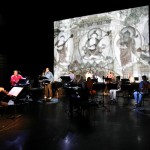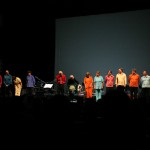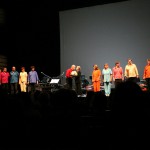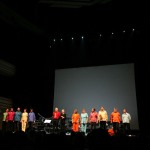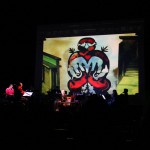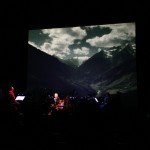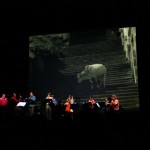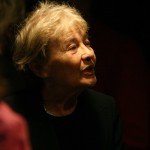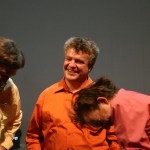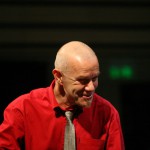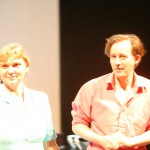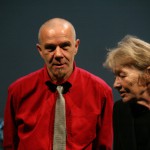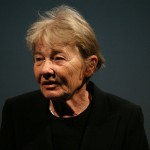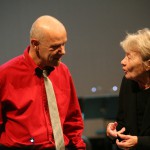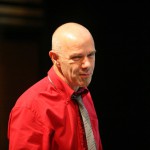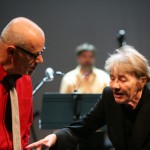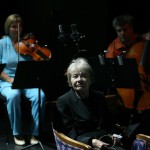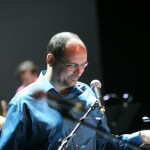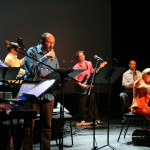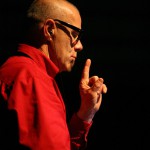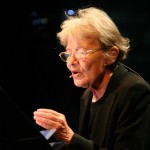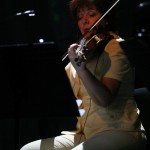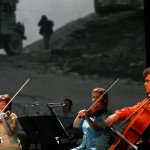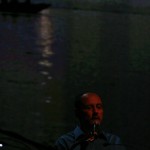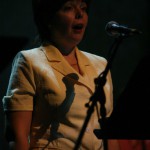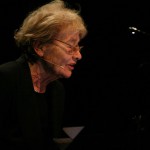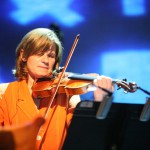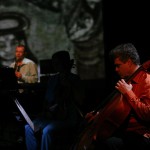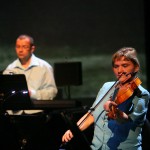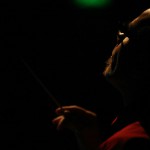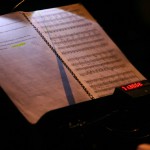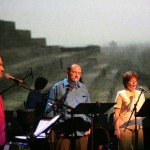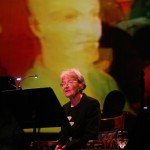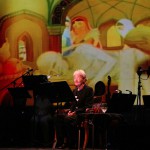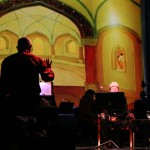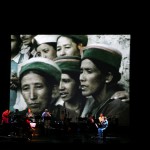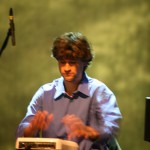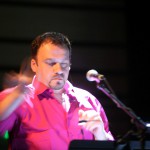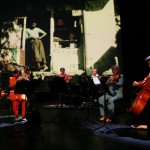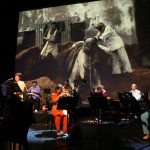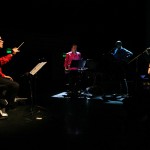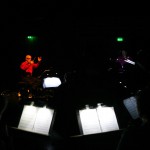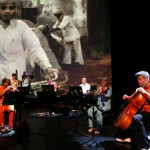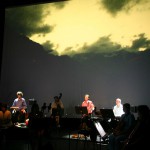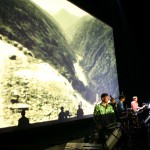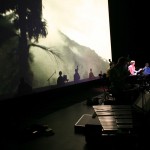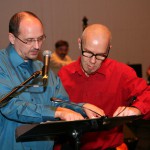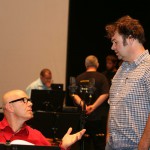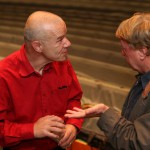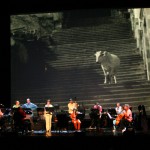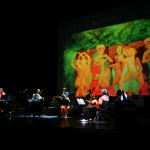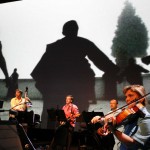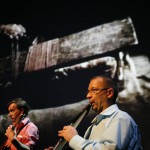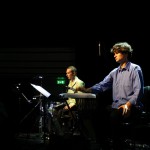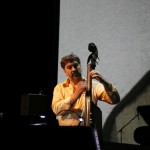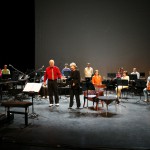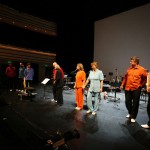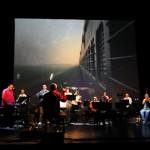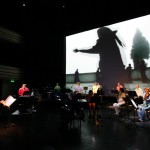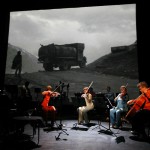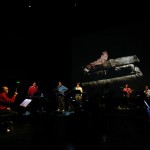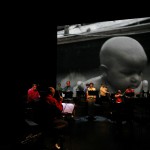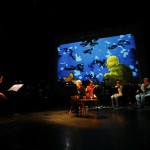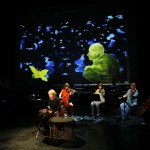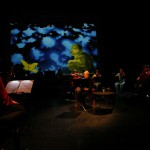7 October 2009
PALACE OF ARTS – BÉLA BARTÓK HALL
Tibor Szemző – László Sári
CSOMA
cinematic opera
“A human being does not have any roots. He or she must make a pilgrimage through the human condition.
That means Ladies and Gentlemen, that we are all guests of life.“
George Steiner
CINEMATIC MUSIC COMPANY
Mari Törőcsik – storyteller; Tibor Szemző – film, music, conductor, bassflute; László Sári – text;
Ildi Fodor – voice, 2nd violin; Laca Kéringer – voice, 8mm-phone; Zoltán Mizsei – voice, keyboards, wind controller; Orsolya Winkler – 1st violin, gardon; Enikő Nagy – viola; György Déri – cello; Szabolcs Keresteš – keyboards, wind controller; T. Bali – electric guitar; Mihály Huszár – electric double bass; Tamás Schlanger – percussions, gardon; Bálint Pödör – percussions
CONTRIBUTORS OF THE FILM
István “Taikyo” Szaladják – cinematography; Teri Losonci – film editor; Gábor Roskó – paintings of animations; Károly Kása Papp, Bálint Kolozsvári animations; László Hortobágyi, Zoltán Regenye, Károly Liszkai, Tamás Zányi – sound engineers; György Durst, Attila Bognár film producers
Gábor Ferenczi – stage; Mari Benedek – costumes; Zoltán Regenye – sound engineer; Károly Csaba Molnár – system engineer; Attila Szirtes – lights; Anikó Rácz – production manager
PRE RECORDED VOICES
Lobsang Dhamchoe – Milarepa, (Tibetan ‘Gurma-song’); Lama Lobsang Gedun (Tibetan) – Recitation from the from the Tibetan Book of the Dead; Tsering Wangyal (Tibetan) – Milarepa, 1st Lama; Divya Mani (Hindi) – Indian Schoolteacher and and Hindi Storyteller; Nikos Sergis (Ancient Greek) – Strabo; Satya Vrat Shastri (Sanskrit and Pali) – The Professor, Gautama Buddha; Tim Wilkinson (English) – A. Henry Savage Landor and the Wanderer saying farewell; Zoltán Rihmer (Latin) – Classmate from Nagyenyed; Rumpali Mukherjee (Bengali and English) – Bengali Schoolmistress and the Moon; Liz Szász British Guide; Wilhelm Droste – German man (J. W. Goethe); Djabra Ankush (Arab) – The Wanderer and the Moon; Madelaine Meran – German Lady; Jampa Dhadak (Tibetan) – 2nd Lama; AmirSaman Nikzad (Persian) – The Fairy of Wondrous Awakening and the Yearning Wanderer; Ashok Roy (Bengali) – Francis Bain; Zarrin Tadj Lotfi Shodjaian – Persian Storyteller; Tsewang Dolma (Tibetan) – Yomo; Ngawang Tenzin Gyatso (Tibetan) – 3rd Lama; Indukant Angiras (Hindi) – The Indian Master of Ceremony; Archana Tripathi (Hindi) – The Indian Lady-in-waiting; Bushan Sharma (Hindi) – The King in the Dream; Tarak Mozumdar – Bengali Storyteller; Subrata Dutta-Chaudhuri (Bengali) – Meditating Wanderer; Bandana Mukhopadhyay – Sanskrit Narrator; Caroline Bodóczky – Meditating British Lady; Wang Yue – Chinese man
SPONSORS:
Flórian Műhely, Artisjus Alapítvány, AER Central Europe, NKA
COPRODUCTION PARTNERS:
ERA New Horizons (Wroclaw), MŰPA Budapest Arts Palace
The poor scholar was one of our century’s great, original pioneers. As a student, together with two other fellow-students, he solemnly vowed to devote his life to the task of penetrating Central Asia in quest of the origin of his nation. In the first thirty-five years of his life he prepared himself for the task in Europe, and during the next twelve years he travelled around as a pilgrim in Asia or lived a life of solitude and privation in the cold of Tibet, learning from Buddhist monks. He spent the remaining eleven years of his life publishing in India parts of the material he had collected himself. […] His fate was typical of scholarly pioneers. Someone else reaped the rewards of his efforts. To the scholars of his century Csoma was an obscure, Transylvanian figure, abandoned among the Himalayan hills-however, from the summits a giant cast its shadow on Central Asia. (W.W. Hunter)
the text of the booklet
Alexander Csoma de Körös
He is perhaps one of the strangest characters of Hungarian scholarship. Driven by Romantic national pride, he set off for Asia in the early 19th century to find the ancestors of the Magyars, or any traces they may have left behind. At that time it was thought that the Magyars had come to the Carpathian Basin from Asia. Csoma had prepared for this journey from early boyhood. Back in his native town of Nagyenyed in Transylvania, he had studied Classics and learned several modern languages so that he could research the historical sources on the origins of that people, later going on to the University of Göttingen to study with the great Orientalists of his day and learning Turkish, Arabic and Persian. He was fluent in thirteen living and dead languages by the time he set out in autumn 1819, and had added a further seven by the time he died.
Apart from the Mediterranean sea crossings, Csoma made the entire trek from Transylvania, via Bucharest, Sofia, Philippopolis (Plovdiv), Ainos, Alexandria, Cyprus, Aleppo, Baghdad, Tehran, Bukhara, Kabul and Leh on foot, arriving years later in India where he was introduced to Buddhism. Settling in a Tibetan monastery at Kanam, close to the Tibetan border, in the foothills of the Himalayas, between 1827 and 1830 he read through, abstracted and annotated for the Western world the 105,000 pages of the 325 volumes of the Tibetan-language Buddhist “Bible”, created a Tibetan-English dictionary and a Tibetan grammar (published at Calcutta in 1834). Csoma was thus a pioneer in revealing Buddhism and Tibetan culture to the West, and the founder of the discipline of Tibetology. Having completed those researches, instead of travelling into Central Asia, he remained in Calcutta to study Sanskrit, Bengali, Hindi and Maharatta literature, with unknown objectives, taking up a post as librarian at the headquarters of the Asiatic Society of Bengal. He was hardly ever seen outside the library building. As a renowned scholar, he would often receive visitors. The once reticent, soft-spoken man was cheerful and talkative with his guests. However, he would never talk about himself, only his readings. Then, all of a sudden, after eight years of library work, he embarked on a new journey. He set off towards Lhasa, the capital of Tibet. He did not get far: in 1842, at the age of fifty-eight, he died in the Himalayas near the today’s border between India and China.
“Csoma” Cinematic Opera
A film opera – at first hearing this is
an easily comprehensible expression; it becomes clearer still when you learn that the composer describes it as: cinematic opera. Tibor Szemző conceived the stage work during his first trip to the Himalayas. He initially created the film, A Guest of Life – Alexander Csoma de Körös, then the opera. The film was screened at leading festivals across the world, and received three awards at the 37th Hungarian Film Week (Director’s Prize for visual expression, Best Sound, and the Best Music Prize from the student jury); the 58th Locarno International Film Festival – Critics’ Week gave it Special mention and in 2006 it won the Hungarian Film Critics Prize. In 2007, it took one of the principal prizes of Mediawave Festival. (csomafilm.szemzo.hu)
During his journey in the Himalayas in 1999, Szemzô made sound recordings and shot film with an 8 mm camera. These film diaries and a script by László Sári formed the basis for the film and shooting began in 2003 with the cameraman István “Taikyo” Szaladják. This filmed visual material forms one of the layers of the film. A second layer is the paintings of Gábor Roskó which evoke old projector slides and are brought to life in animation scenes which transport the listener and viewer to fabled lands. The alternation of these two layers creates the structure for the opera’s action, but they differ in their basic moods: the texts audible under the sound recordings made in India and Tibet tend to evoke Eastern philosophy and wisdom, while the animated legends bring to life the world of childhood tales.
The opera reproduces Csoma’s life and also tries to traverse the spiritual metamorphosis and inner journey – with the aid of sounds and images – which Alexander Csoma either travelled or endeavoured to follow. The theme is Csoma’s secretiveness which was his personal trait: Szemző was uniquely drawn to the reason for Csoma’s introversion. To communicate this, he made use of pictures, instrumental and vocal music as well as verbal and linguistic music. The texts which are heard in a number of different languages comprise another important element of the musical layers of the opera, which – since very few listeners will be able to comprehend them all – reveal themselves to the listener in terms of their music.
The literary source material for László Sári’s text is drawn from works by Strabo, Milarepa, Shu-La-Tse, Tsangyang Gyatso, the sixth Dalai Lama, Siddhartha Gautama Buddha, Francis Bain and others, as well as The Puranas and the Tibetan Book of the Dead. So we hear the music of languages which Csoma spoke and understood, including Ancient Greek, Arabic, Persian, Sanskrit, Pali, Bengali, Hindi and many others, which are presented in both spoken and song form. Treating spoken texts as music is extremely important for Szemzô but his technique differs from the “Sprechgesang” methods familiar from the early 20th century. He “orchestrates” the text first to the chosen language, then makes recordings with native speakers. These then attain their final form embedded into the operatic texture.
Tibor Szemző was born in Budapest in 1955. He studied at the Béla Bartók Conservatoire and then the Academy of Music in Budapest. For many years he was a member of Schola Hungarica. From the mid 1970s, he was familiar to audiences as both performer and composer. He founded a quartet and was the founder of the acclaimed Hungarian modern ensemble Group 180, which functioned between 1979 and 1989. He was also a member of the New Modern Acrobatics (performance group, 1987–1991). His own groups are: Mixed Ensemble (1992–1993), The Gordian Knot Company (from 1998), and the Cinematic Music Company who are collaborating in the Csoma opera. Cinema, film and installations have played an important role in Szemzô’s career. He says he was deeply influenced by Steve Reich and John Cage. His work has been premièred in numerous European countries, as well as North America, Japan and India. He has released thirteen solo albums and a DVD for primarily English and Hungarian record labels. He has collaborated among others with film director Péter Forgács, performance artist János Szirtes, media artist Tamás Waliczky and actor/director István Bálint.
Mari Törőcsik graduated from the Theatre and Film College in 1958 before joining the National Theatre. She enjoyed her first successes while still a student, most notably in Zoltán Fábri’s film Merry-Go-Round. She has since appeared in over a 100 films. From 1979, she also worked as artistic director of the Kisfaludy Theatre in Gyôr. She was a member of the Hungarian Film Studios (1980–1990), the Szolnok Szigligeti Theatre (1990–1993), and then the Budapest Artist’s Theatre, where she was also managing director. Since 2002, she has performed again at the Budapest National Theatre. The diversity of her roles is shown by her tremendous success in everything from tragedy to musical theatre. She has won many awards, including the Béla Balázs Prize, the Mari Jászai Prize, and the Artist of Merit and Supreme Artist Award, the Kossuth Prize, as well as awards at the Cannes, Chicago, Taormina, Solerno, Madrid, Karlovy-Vary film festivals for best female actress. She has received Lifetime Achievement Awards among others in Cannes and Karlovy Vary. Since 2000 she has been the “Nation’s Actress”.
The majority of musicians in the Cinematic Music Company previously worked with Tibor Szemző in The Gordian Knot Company. Szemző not only conducts but also performs on the bass flute in the opera. Elements of the instruments include Szemző’s own 8mm phone, a wind controller and an electric double bass.
